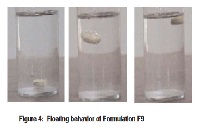Development and evaluation of gastro retentive floating tablets of anti-hyperlipidemic drug
Keywords:
Simvastatin, Direct compression, HPMC K4M, HPMC K15M, HPMC K100M.Abstract
The aim of the present study was to develop Gastro retentive effervescent floating tablets (GREFT) containing 20 mg of simvastatin were developed by direct compression method using HPMC K4M, HPMC K15M, HPMC K100M with different drug to polymer ratio. Tablets were evaluated for their physical characteristics, viz., hardness, friability, drug content and floating properties. Further, tablets were studied for in vitro drug release characteristics for 12 h. The tablets exhibited controlled and prolonged drug release, with optimum hardness, consistent uniformity in weight and low friability. The formulation with F2 (HPMC K100M 1:3 ratio) showed 85.83 % drug release at the end of 12 h and exhibited optimum floating lag time. A decrease in release rate of the drug was observed on increasing polymer ratio and also by increasing viscosity grades of the polymer (HPMC). Drug release from effervescent floating matrix tablets was sustained over 12 h with buoyant properties. DSC study revealed that there is no drug excipient interaction. Based on the release kinetics, all formulations best fitted the Higuchi, first-order model and non-Fickian as the mechanism of drug release. Optimized formulation (F9) was selected based on the similarity factor (f2) (71.32) and invitro dissolution was used in radiographic studies by incorporating BaSO4. In vivo X-ray studies in human volunteers showed that the mean gastric residence time was 5.4 ± 0.32 h.
References
Talukder R, Fassihi R. Gastroretentive Delivery Systems: A Mini Review. Drug Dev Ind Pharm.2004; 30(10): 1019-28.
Garg R, Gupta GD. Progress in Controlled Gastroretentive Delivery Systems. Trop J Pharm Res. 2008 Sep; 7(3): 1055-66.
Patil JM, Hirlekar RS, Gide PS, Kadam VJ. Trends in floating drug delivery systems. J Sci Ind Res. 2006 Jan; 65: 11-21.
Corsini A, Bellosta S, Baetta R, Fumagalli R, Paoletti R, Bernini F. New insights into the pharmacodynamic and pharmacokinetic properties of statins. Pharmacology and Therapeutics.1999 Dec; 84(3): 413-428.
Schachter M. Chemical, Pharmacokinetic and Pharmcodynamic Properties of Statins: an update. Fundamental and Clinical Pharmacology. 2004 Nov; 19(1): 117-25
Prueksaritanot T, Ma B, Yu N. The human hepatic metabolism of simvastatin hydroxyl acid is mediated primarily by CYP3A and not CYP2D6. Br J Clin Pharmacol. 2003 July; 56(1): 120- 124.
Grozdanis MT, Hilfinger JM, Amidon GL, Kim S, Kijek P et al. Pharmacokinetics of the CYP3A substrate Simvastatin following administration of Delayed Versus Immediate release oral dosage forms. Pharmaceutical research. 25(7): 1591-1600.
Brittain.H. Physical Characterization of pharmaceutical solids. Marcel Dekker .Inc. 1995.
Gambhire M. S., Bhalekar M.R., Gambhire V. M. Simvastatin loaded Solid lipid nanoparticles: Formulation optimization using Box Behnken design, characterization and in vitro evaluation Cur Pharma Res 2011;1: 157 – 164.
Lucie Novakeva, Dalibor Satinsky, Petr Solich. HPLC method for the determination of simvastatin and atorva statin. Trends Anal Chem 2008 ; 27: 352 – 367.
M. Rosa, H. Zia and T. Rhodes, Dosing and testing in-vitro of a bioadhesive and floating drug delivery system for oral application, Int. J. Pharm.1994; 105: 65–70.
Kendre PN. Oral Sustained Delivery of theophylline floating matrix tablets: Formulation and in-vitro evaluation. Int J PharmTech Res. 2010 Jan; 2(1): 130-9
T. Higuchi, Rate of release of medicaments from ointment bases containing drugs in suspensions,Pharm. Sci. 1961;50: 874–875.
R. W. Korsmeyer, R. Gurny, E. Doelker, P. Buri and N. A. Peppas, Mechanisms of solute release from porous hydrophilic polymers, Int. J. Pharm 1983;15: 25–35.
N. A. Peppas, Analysis of Fickian and non-Fickian drug release from polymers, Pharm. Acta Helv. 1985;60: 110–111.
Xu G, Sunada H. Influence of formulation change on drug release kinetics from hydroxypropylmethylcellulose matrix tablets. Chem Pharm Bull (Tokyo). 1995;43:483 -487.
Ingani HM, Timmermans J, Moes AJ. Conception and in vivo investigation of peroral sustained release floating dosage forms with enhanced gastrointestinal transit. Int J Pharm. 1987;35:157 -164.
Moore J.W., Flanner H.H. Mathematical comparison of dissolution profiles, Pharm. Tech.1996; 20: 64–74.






